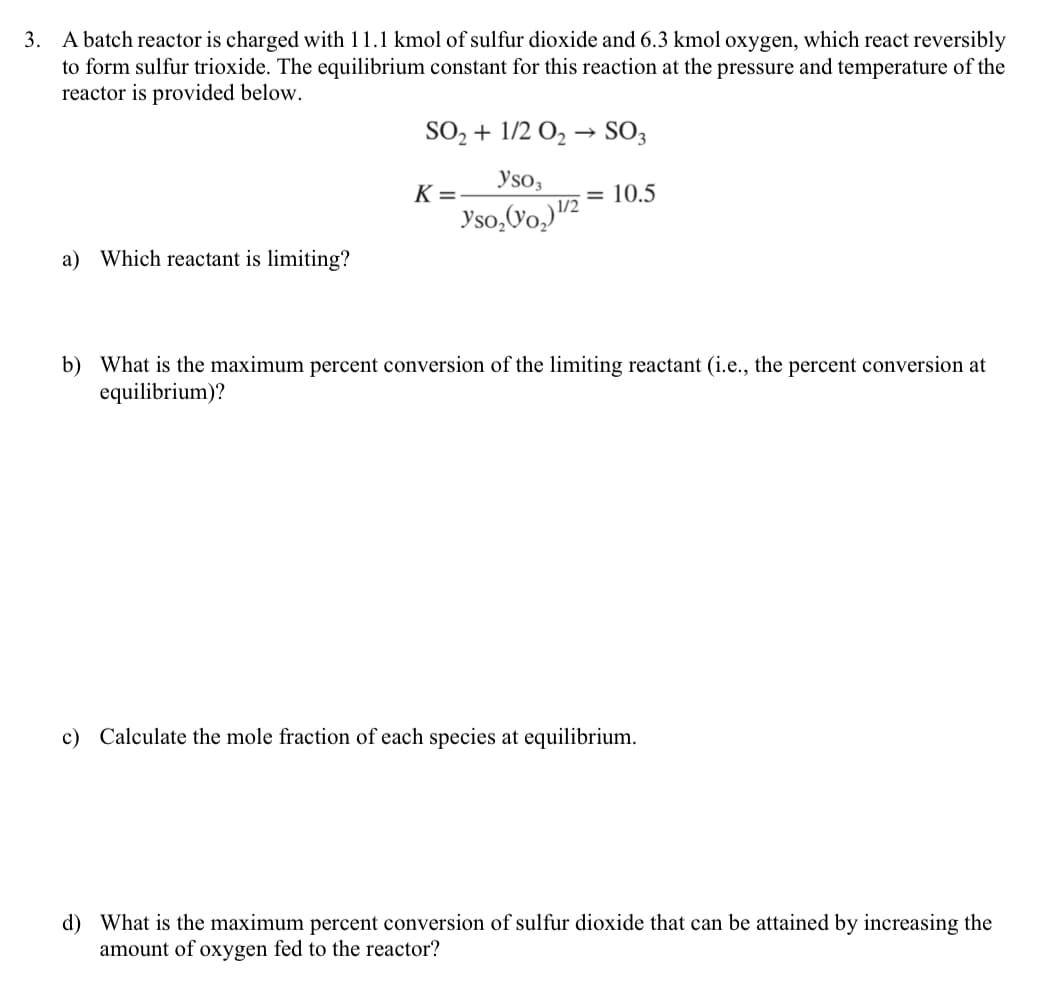A batch reactor is charged with 11.1 kmol of sulfur dioxide and 6.3 kmol oxygen, which react reversibly to form sulfur trioxide. The equilibrium constant for this reaction at the pressure and temperature of the reactor is provided below. a) Which reactant is limiting? SO₂ + 1/2 O₂ → SO3 yso3 yso₂ (VO₂) ¹/2 K= = 10.5 b) What is the maximum percent conversion of the limiting reactant (i.e., the percent conversion at equilibrium)? c) Calculate the mole fraction of each species at equilibrium.
A batch reactor is charged with 11.1 kmol of sulfur dioxide and 6.3 kmol oxygen, which react reversibly to form sulfur trioxide. The equilibrium constant for this reaction at the pressure and temperature of the reactor is provided below. a) Which reactant is limiting? SO₂ + 1/2 O₂ → SO3 yso3 yso₂ (VO₂) ¹/2 K= = 10.5 b) What is the maximum percent conversion of the limiting reactant (i.e., the percent conversion at equilibrium)? c) Calculate the mole fraction of each species at equilibrium.
Introduction to Chemical Engineering Thermodynamics
8th Edition
ISBN:9781259696527
Author:J.M. Smith Termodinamica en ingenieria quimica, Hendrick C Van Ness, Michael Abbott, Mark Swihart
Publisher:J.M. Smith Termodinamica en ingenieria quimica, Hendrick C Van Ness, Michael Abbott, Mark Swihart
Chapter1: Introduction
Section: Chapter Questions
Problem 1.1P
Related questions
Question

Transcribed Image Text:3. A batch reactor is charged with 11.1 kmol of sulfur dioxide and 6.3 kmol oxygen, which react reversibly
to form sulfur trioxide. The equilibrium constant for this reaction at the pressure and temperature of the
reactor is provided below.
a) Which reactant is limiting?
SO₂ + 1/2 O₂ → SO3
yso3
yso₂ (VO₂) ¹/2
K=
= 10.5
b) What is the maximum percent conversion of the limiting reactant (i.e., the percent conversion at
equilibrium)?
c) Calculate the mole fraction of each species at equilibrium.
d) What is the maximum percent conversion of sulfur dioxide that can be attained by increasing the
amount of oxygen fed to the reactor?
Expert Solution
This question has been solved!
Explore an expertly crafted, step-by-step solution for a thorough understanding of key concepts.
This is a popular solution!
Trending now
This is a popular solution!
Step by step
Solved in 5 steps with 5 images

Recommended textbooks for you

Introduction to Chemical Engineering Thermodynami…
Chemical Engineering
ISBN:
9781259696527
Author:
J.M. Smith Termodinamica en ingenieria quimica, Hendrick C Van Ness, Michael Abbott, Mark Swihart
Publisher:
McGraw-Hill Education

Elementary Principles of Chemical Processes, Bind…
Chemical Engineering
ISBN:
9781118431221
Author:
Richard M. Felder, Ronald W. Rousseau, Lisa G. Bullard
Publisher:
WILEY

Elements of Chemical Reaction Engineering (5th Ed…
Chemical Engineering
ISBN:
9780133887518
Author:
H. Scott Fogler
Publisher:
Prentice Hall

Introduction to Chemical Engineering Thermodynami…
Chemical Engineering
ISBN:
9781259696527
Author:
J.M. Smith Termodinamica en ingenieria quimica, Hendrick C Van Ness, Michael Abbott, Mark Swihart
Publisher:
McGraw-Hill Education

Elementary Principles of Chemical Processes, Bind…
Chemical Engineering
ISBN:
9781118431221
Author:
Richard M. Felder, Ronald W. Rousseau, Lisa G. Bullard
Publisher:
WILEY

Elements of Chemical Reaction Engineering (5th Ed…
Chemical Engineering
ISBN:
9780133887518
Author:
H. Scott Fogler
Publisher:
Prentice Hall


Industrial Plastics: Theory and Applications
Chemical Engineering
ISBN:
9781285061238
Author:
Lokensgard, Erik
Publisher:
Delmar Cengage Learning

Unit Operations of Chemical Engineering
Chemical Engineering
ISBN:
9780072848236
Author:
Warren McCabe, Julian C. Smith, Peter Harriott
Publisher:
McGraw-Hill Companies, The